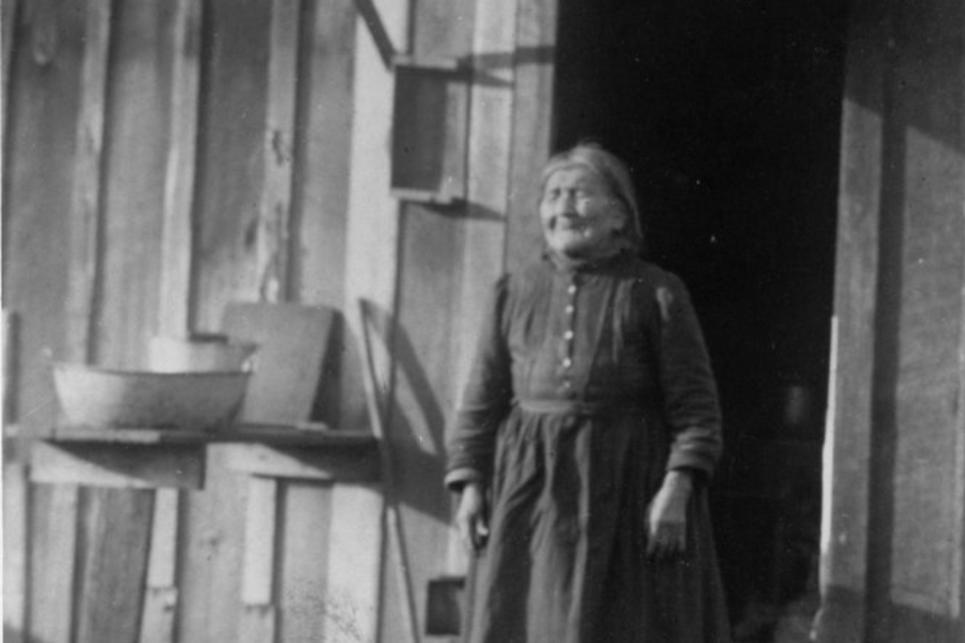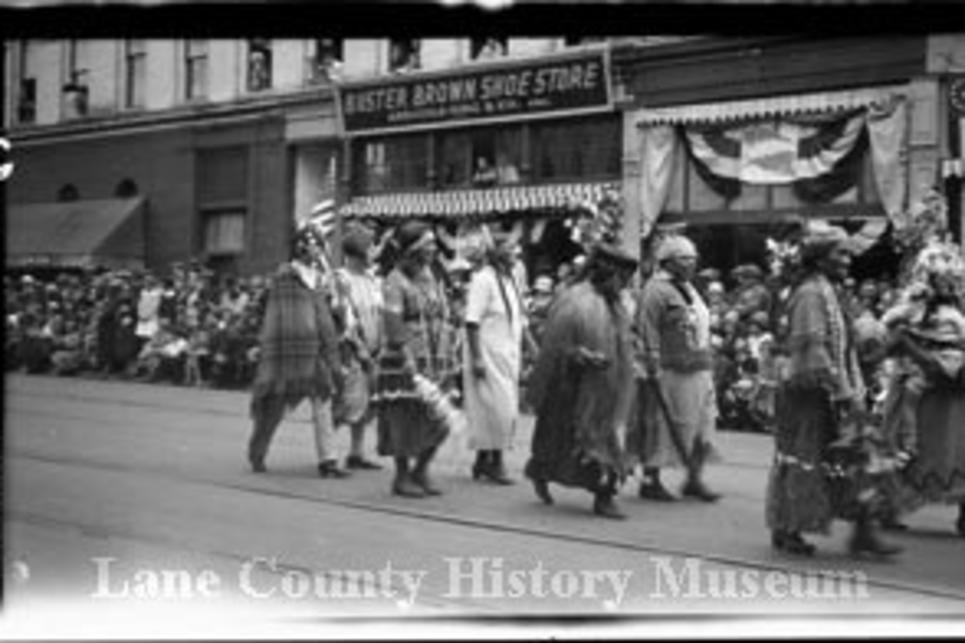The Eugene, Cascades & Coast region (Lane County) sits astride a diverse ecological landscape with lands on the Oregon coast, coast mountains, Willamette Valley prairies, Cascades foothills and high mountains. There were numerous tribes who lived in this landscape for more than 10,000 years, the tribes say since time immemorial.
The original tribes of the Oregon Coast in this region were the Siuslaw and Alsea tribes. They had a coastal culture and accessed many environments from inland coastal mountains for hunting and gathering to the shore and ocean for shellfish, fish, and sea mammals. The tribes lived in the river estuaries and up into the river basins where they had access to many environments to gather food as well as easy and efficient travel with canoes. The tribes would travel up and down the coast to trade hunt sea mammals, fish for salmon, collect smelt, and access rich shellfish beds throughout the year.

Siuslaw Tribe Members on the Siuslaw River Near Florence
The Siuslaw and Alsea peoples became part of the Coast Reservation in 1855. They did not have to remove unlike other tribes because the Coast Reservation as placed over their lands. In 1856 tribes from southwestern Oregon were removed up the coast to be settled at the Siuslaw and Alsea River outlets, these encampments became sub-agencies of the Coast Reservation and hosted Coos, Coquille, Tututni, Chetco, and many other tribes from the lower coast.
Some of these tribes were placed first at the Umpqua Reservation south of the Coast Reservation until 1862 and then removed to the Coast Reservation. The central and southern coast tribes had all signed the 1855 Coast Treaty, which was never ratified. Some of the tribes were never paid for their lands and when they were removed lost all claims to their original village sites. They waited for seventeen years at the Coast Reservation for the ratification of the treaty, in vain. In 1865 the Coast Reservation was reduced by the removal of the Yaquina tract, which became open to settlement. Then in 1875 the southern half of the reservation, named the Alsea Reservation was also terminated and tribal peoples were forced to remove to the remainder of the Coast Reservation, renamed the Siletz Reservation which was substantially the boundaries of the present Lincoln County. The Alsea peoples were removed by 1878 to the Salmon River encampment under promises of houses, which never came. Many of the Siuslaw peoples never abandoned their lands and became part of the growing coastal communities.
The Coastal tribes today are members of the present-day Confederated Tribes of Siletz or Confederated Tribes of Coos, Lower Umpqua and Siuslaw tribes.

Siletz mother with baby in a woven cradleboard - 1915
The Siuslaw had significant land claims deep into Lane County to the headwaters of the Long Tom River. They bordered upon the territories of the Kalapuyan tribes of the Willamette Valley. Within Lane County were numerous Kalapuyan tribes and bands, the Chelamela or Long Tom peoples along the Long Tom River, to the north the Chemapho or Muddy Creek peoples, the Chafin or Chifin Kalapuyans at Eugene, the Pe-u or Mohawk Kalapuyans of the Mohawk Valley, the Winefelly Kalapuyans of Springfield and Pleasant Hill, and the Yoncalla or Kommema Kalapuyans who lived partly along the Row River and partly within the Umpqua basin.
The Kalapuyans are one of the most well-known tribes because of their central location to Eugene and Springfield. They had numerous villages along the rivers and would harvest roots, grains, and bulbs from the prairies, hunt elk and deer, and build weirs and fish traps to catch fishes in the rivers and streams. They were known to have seasonally moved about their territories, sometimes sharing territories with friendly neighbors, and encamp where fields of camas were ready to dig in the early summer, or oaks were releasing acorns in the fall. The Kalapuyans shared their lands to the east with the Molallan peoples. The Mountain Band of Molallans lived in Lost Valley and up into the Oakridge area. They would access the valley prairies for roots and then travel into the Cascades to hunt, pick huckleberries and gather hazelnuts.
Besides these many tribes, bands of Klamath peoples would travel into the valley in the summers on the Klamath trail to encamp in the valley and hunt elk.

Kalapuyan woman Eliza Young at her home in the South Willamette Valley
The Kalapuyan and Molallan tribes of the valley faced many challenges beginning in the 1840s. Many thousands of American settlers began invading the Willamette Valley by 1844 as they arrived on the Oregon Trail. The white men took allotments of land, land that the tribes used to gather foods, and began plowing up the prairies and planning crops. Plowing destroyed the many prairie foods of the Kalapuyans and Molallans forcing them each year to struggle harder to find enough foods to harvest and preserve for the cold and long winters. The settlers hunted out the game and fished the rivers and eliminated many food sources forcing the tribal peoples to begin working as laborers for the farmers. The native peoples learned farming and helped build many farms. Fencing the fields further kept them from their original lands forcing them to ever decreasing parcels of lands that the settlers “allowed” them to live on. The claims of the Americans were taken without any sale of tribal lands to the United States for decades.
In the 1830s the tribes also encountered an epidemic of malaria which reduced many tribes by some ninety-five percent. By 1850 the Kalapuyans numbered only about 600 people in the whole valley. In 1850 the federal government passed the Oregon Donation Land Claims Act certifying previous land claims and giving 640 acres or one-mile square claims to married men. It was not until 1855 that the tribes signed a treaty for the purchase of their lands. By this time, the numbers were so decreased, and the threats to their security so elevated that they saw no other path forward for survival of their peoples. The Willamette Valley Treaty was ratified March 3, 1855. That month many temporary encampments were created for the Kalapuyans in the valley, and tribes were made to remove to these locations to wait for the permanent removal. There were temporary reservations in Lane County at the Jacob Spores ranch, in the Mohawk Valley and around Alpine, Oregon. In October 1855 more tribes were removed to temporary reservations and preparations began to move all tribes to a permanent reservation.
During 1855 many wars and conflicts were occurring in the region between tribes and settlers. In the south, the Rogue River tribes had been attacked on their reservation and so fought against the militias to survive and take back their lands. On the Columbia, many tribes were upset at the white settlements and set up attacks to attempt to drive the whites from their lands, because they had yet to be paid for the taking of the lands. In eastern Oregon and in the Klamath Basin there were conflicts with the Paiute and Klamath peoples over land claims and incursions into tribal territories. All these wars caused many settlers to call for the extermination of all tribes in Oregon.
In January of 1856 Joel Palmer the Indian Superintendent of Oregon ordered all the tribes onto the Indian reservations to protect them from further violence caused by settlers, gold miners and militia. All the Kalapuyans and Molallans went to the Grand Ronde Indian Reservation and were there by April 8, 1856. At the reservation Palmer had a fence built and hired citizen guards to keep any white people from entering the reservation and attacking the tribes.
After most of the tribes were removed, they were made to remain on the Grand Ronde Reservation. Their guns were taken, and they had to subsist on food provided by the Indian agents. Provided was beef, pork, flour, oil, and potatoes, forcing them to radically change their diet. Food, housing, and health supplies were slow to get to the reservation and for some 20 years the tribes lived in poverty. The federal Indian agents did not give allotments to the tribe as promised in the treaties, and the land in the Grand Ronde valley was very poor for agriculture so many tribal people starved and were malnourished for years. Services like education and health care were inconsistent and ineffective for years. The tribes were forced to forage the Coast Range for food, but many people died waiting for their treaty rights to be honored.
The tribal people had to ask permission to travel outside the reservation because they were not given U.S. citizenship and were considered members of Indian nations. Still, many of the Kalapuyans and Molallans would annually travel back to their original homelands and visit friends among the white settlers or fish, hunt or gather in their usual ways. There were many visitations to the Eugene-Springfield area to participate in county fairs, rodeos, and parades. Tribal families became migrant farmworkers, with whole families traveling into the valley to help harvest the crops of the white farmers for money and trade. Many Native men became loggers and became part of the crews who harvested timber from the Cascades and Coast ranges.

Kalapuya Peoples at Eugene parade on Willamette Street - 1926
Several families of Kalapuyans and Molallans moved off the reservation and took off-reservation Indian Allotments in their original territories. This is the case of the Halo family of Yoncalla— Kalapuyans who remained off the Grand Ronde Reservation to take allotments south of Cottage Grove. Chief Halo’s sons became laborers for the white settlers, supplying wood from the forests to help build many farms. They were good friends to the Applegate family of Yoncalla Kalapuyans for generations. In the area of Oakridge, Charley Tufti and his family took up an off-reservation Indian Allotment and lived there for many years. Groups of Kalapuya, Molalla, and Klamath peoples would regularly meet in the summers at “campmeetings” in Pleasant Hill and at the Cottage Grove fairgrounds. In these ways, the tribes maintained a relationship with their original homelands.
Eliza Young was one of the Kalapuyans who remained off the reservation most of her life. She came from the Pe-u Kalapuya tribe in the Mohawk valley and lived for a time with the Spores family in the 1850s. She married twice and finally moved to Brownsville and had two children. She and her husband, Jim Young, remained in Brownsville most of their lives and Eliza survived her whole family and would do odd jobs around town for the white settlers. In the 1910s she became blind and continued weaving and became known as Indian Eliza the blind basket weaver. The people of Brownsville hosted her for years until she passed in the 1920s.
Today, the Kalapuyans, and Molallans are mostly members of two reservations, Grand Ronde and Siletz. There was a family of Molalla that also went to live at Warm Springs. The Alsea, Siuslaw, and other coastal peoples are members of the Siletz and the Coos, Lower Umpqua and Siuslaw tribes. The Klamath are members of the Klamath tribe with relations on many reservations. The Siletz and the Coos, Lower Umpqua and Siuslaw maintain offices in Eugene. The Coquille Tribe operates a medical clinic for Indigenous patients in Eugene.
